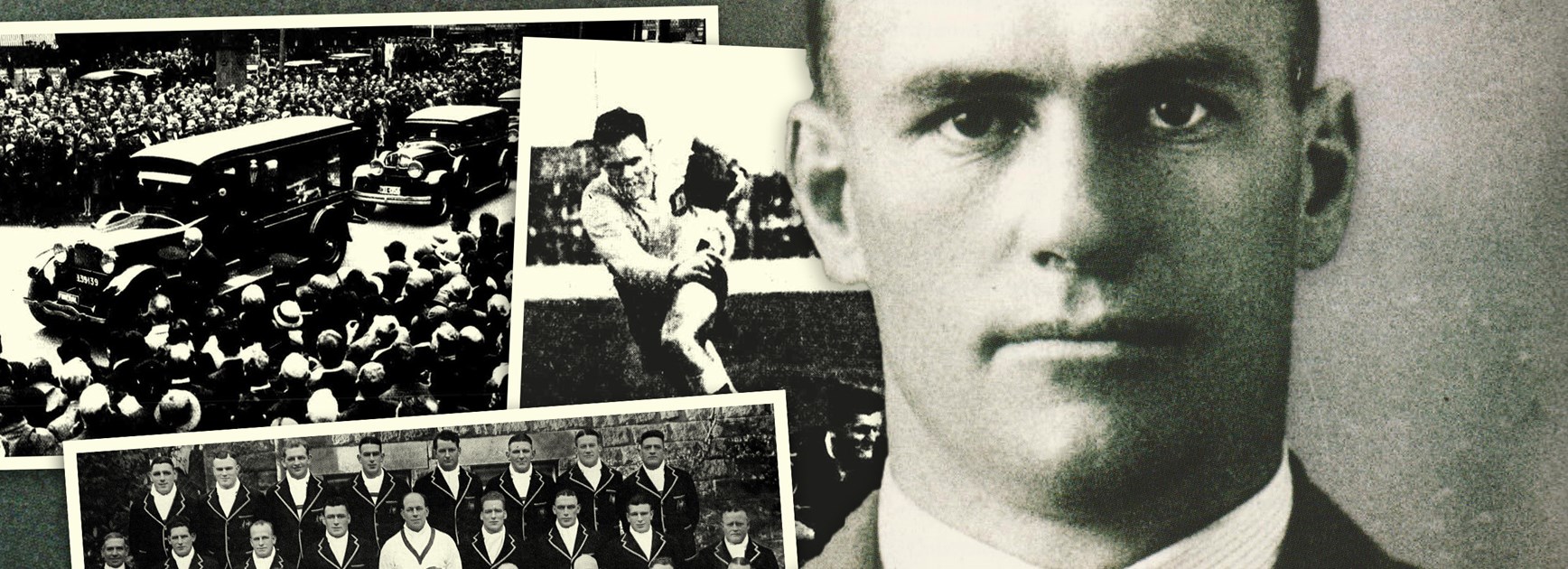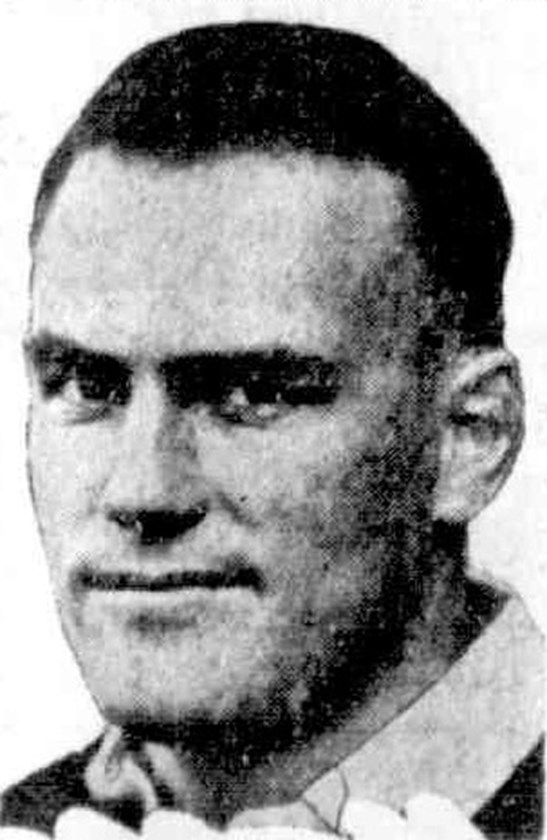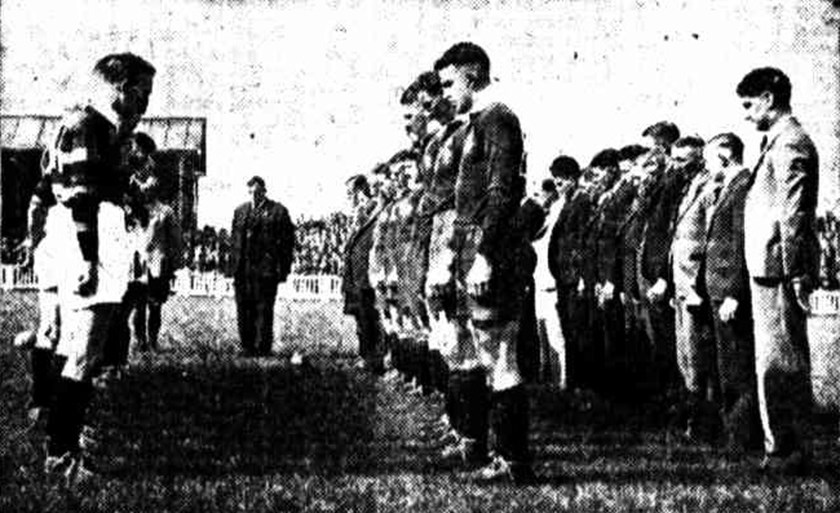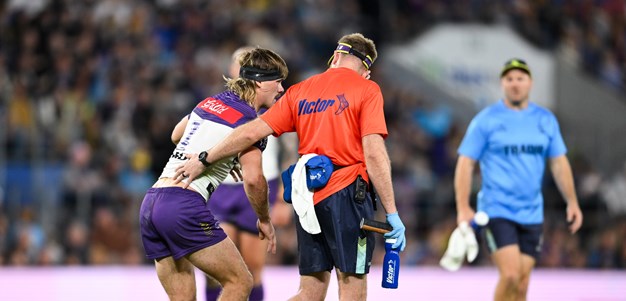
"I was with Ray until the end."
Sam Haron isn't the name of someone synomonous with anything remarkable to the general public. But for a brief period, he was an absolute blessing to one rugby league player, his family and the Rugby League organisations in Australia and England following the untimely death of Kangaroos centre Ray Morris in 1933.
Aged 52, Haron set off on an epic journey to England from Sydney, joined on his venture by the Kangaroos squad as they too embarked on their voyage to mother England to attempt to wrest the Ashes back.
On Tuesday, July 4, the Kangaroos - among a throng of other travellers - boarded the motorship Manunda, which would take them to Melbourne, where they would board the S.S. Jervis Bay and so begin the long journey to England. As the Manunda was about to set sail, the Kangaroos staged their war cry before waving to their families and fans.
Some of the game's greatest players were on board: future Immortal Dave Brown, Wally Prigg, Sandy Pearce, Vic Hey, Ray Stehr, Frank McMillan and Viv Thicknesse.
One of those players was a pioneer, the first player from the ailing University club to be chosen for Australia, Ray Morris.

He began his career in third grade at Western Suburbs before quickly moving up through the ranks to first grade in 1927.
Morris was a strong and talented centre who was also a capable five-eighth. Wests comfortably qualified for the finals in 1930; however Morris missed the first two games of the series before being selected on the wing in the grand final challenge against St George. He scored a try in what was a comfortable 27-2 win for Wests, securing their first premiership.
In 1931 he was selected for City on the wing against Country, scoring a try on debut. He was then selected for NSW to face Queensland.
In 1932 he shifted to the centres where his game began showing rapid improvement. He was again selected for City and NSW. Wests went all the way to the grand final challenge yet again, but were unable to topple Souths.
At season's end, Morris made the surprising announcement he was joining the University club. His good form in the interstate clashes led to his selection in the Australian squad. When he left for the tour, his University team had managed to sneak into third on the ladder.
The 25-year-old, who was an exceptionally fine surf swimmer and clever amateur wrestler, became the ideal man to lead the physical training sessions on board the S.S. Jervis Bay.
Days after the departure from Western Australia, he was well into his on-board training regime which included aerobics, boxing and shovelling coal. He believed it was necessary to vary the exercise to maximise its effects and to prevent the players from being bored.
In one of the boxing sessions, Morris received a blow to the ear. He wasn't affected initially and continued training. Later in the day he complained of a pain in his ear to the team doctor, who treated it accordingly.

Initially the treatment was ineffective, but eventually the pain dissipated. The ship stopped at Colombo where some of the players spent a day relaxing, while others played an exhibition game on a local cricket ground against each other. Morris took the opportunity to take a dip in a local swimming pool.
The ship set sail the following day, with Morris's ear problems returning, this time more seriously. The doctors had him confined to the ship's hospital quarters for 10 days while his condition was constantly observed. Each day he grew weaker.
After a month on the ship, Morris had gone from one of the fittest and strongest men to being gravely ill. Doctor Gordon and Doctor Clough consulted and agreed to send a wireless message to Valetta in Malta, for an ear specialist to meet the ship upon its arrival.
The next day, Morris was taken ashore to the Blue Sisters' Hospital in Valetta, where he was immediately attended to by Doctor Vella. The specialist advised Morris would require immediate surgery.
Harry Sunderland, the manager of the Kangaroos, had to decide whether to stay in Malta or to sail on and honour the tour program.
Haron then stepped forward and volunteered to stay with Morris to comfort him while in hospital, so the team could continue to England without delay.
Reluctantly, the ship set sail the next day without their beloved teammate, while Haron began a bedside vigil for Morris in his hour of need.
It was discovered Morris had ruptured his eardrum during the boxing session and the injury became infected while bathing in Colombo. Dr Vella feared Morris was suffering from meningitis.
He told Haron to take some time off while Morris was being operated on. Sam went for a drive around Malta to see the sights. He arrived back at the hospital the next day.
"On my return Ray asked me about my trip and seemed cheerful, but early next morning I awakened feeling instinctively that all was not well," Haron said.
He called the doctor but there was little they could do and Morris died a few hours later, with Haron by his side.
"Ray knew that he was dying. He gripped my hand, mentioned his mother, and then died peacefully."

Aboard the S.S. Jervis Bay, the Kangaroos were celebrating the birthday of Fred Neumann when they received the tragic news that Morris had died in Malta. All of the 500 odd passengers were grief stricken and immediately held a memorial service as the ship sailed towards Spain.
Back home, the sporting community were shocked and deeply saddened upon hearing the news. All rugby league games, as well as some rugby union and even Australian Rules games being played that weekend, observed a minute's silence.
Upon arrival in England, Sunderland decided the best way to pay tribute to Ray Morris was to leave his place in the team vacant for the remainder of the tour.
A small ceremony took place in Malta before Haron organised for Morris's body to be embalmed, placed in a casket and then shipped aboard the steamer Hobson's Bay on August 22, back to Sydney. Once the body was safely aboard the ship, Haron then made arrangements to continue his journey to England.
On August 26 in England, the Australian team lined up against St Helens Recs for the first game of their tour. Before the game, a local band played the hymn "Silver Hill" as a tribute to Morris before both sides observed two minutes' silence.
The team travelled to Ilkley the next day where tour co-manager, Wally Webb, greeted Haron.
Back home, on September 23, thousands attended a public memorial for Morris was held. Sydney's Town Hall overflowed with people in what was reportedly one of the largest memorial services Sydney had seen.
His casket was carried by teammates from his two clubs - Charlie Cornwell, Bob Lindfield, Cecil Rhodes and Charlie Wrench from Wests and Ross McKinnon, Gordon Favell, Tom Monaghan and George Sullivan from University.
Also in attendance was the NSWRL board and its founder James Giltinan, along with presidents, secretaries and board members from the QRL, NSW Cricket Association, NSW Baseball Association and NSW Rugby Union as well as committee members and players from all NSWRL clubs and former players such as Dally Messenger, Dinny Lutge, Alec Burdon, Charlie Russell, Webby Neill, Cec Blinkhorn, Claud O'Donnell, Bert Gray, Clarrie Prentice, Arthur Justice, Clarrie Tye, George Bishop and Benny Wearing, among many others.
Upon the Kangaroos' return home, Sunderland announced the tour had made a good profit and consequently, each of the 37 players received £200 each. Also, the family of Ray Morris received his £200, while the £315 doctors' bill and the costs of returning his body to Australia and the burial service were all taken from the tour's profits.
The NSWRL board placed on record the services rendered by Haron for remaining with Morris in his hour of need so he will never be forgotten for his actions during one of Australian rugby league's saddest tragedies.

